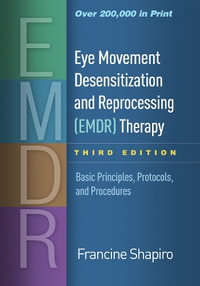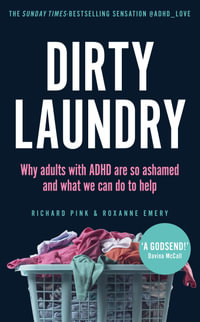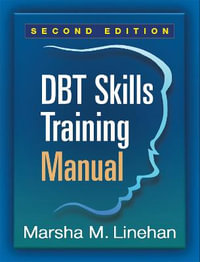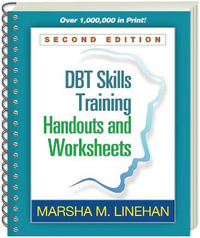
Diagnosis and Treatment Planning in Counseling
By: Linda Seligman
Hardcover | 14 July 2004 | Edition Number 3
At a Glance
488 Pages
Revised
22.86 x 15.24 x 3.18
Hardcover
$296.11
or 4 interest-free payments of $74.03 with
orAims to ship in 7 to 10 business days
As the counseling field enters its second century, students and professionals face more challenges than ever before. Linda Seligman's essential text Diagnosis and Treatment Planning in Counseling has evolved as well, and this third edition synthesizes the latest developments with the spectrum of counseling interventions to create a vital source of practical, up-to-date information. The author recognizes clinicians' varied roles - mentor, mediator, teacher, coach - and keeps them all in focus, assuring her readers of more effective treatment for clients and steadier footing on their own career paths.
Key features of the third edition:
- An overview of the changing face of counseling, from emerging employment opportunities to core competencies for counselors and trainers.
- A broad range of qualitative and quantitative assessment tools, with guidelines for their selection and interpretation.
- A thorough review of the current edition of the Diagnostic and Statistic Manual of Mental Disorders, including strategies for multiaxial assessment.
- The DO A CLIENT MAP, a comprehensive structured approach to treatment planning.
- Expanded coverage of individual, family, and group interventions
- An updated chapter on documentation, report writing, and record keeping, with sample reports and forms.
- Brand-new chapters on career and organizational development counseling, and ethical standards for counselors.
- A predictions chapter identifying trends most likely to influence the future of the field.
- Case studies, models, and examples throughout.
A worthy addition to any counselor education program, this important volume is equally useful to both beginning and seasoned counselors, whether the setting is the psychiatric clinic, the school, or the rehab center. Seligman clearly sets out the concepts and strategies the reader needs to know to be the flexible, proactive counselor of today - and tomorrow.
| The Evolving Role of the Counselor | p. 1 |
| The Evolution of the Counseling Profession | p. 1 |
| Definitions of Counseling | p. 2 |
| Early History of the Counseling Profession | p. 3 |
| Counseling in the 1940s, 1950s, and 1960s | p. 4 |
| Counseling in the 1970s | p. 6 |
| Counseling in the 1980s | p. 7 |
| Counseling in the 1990s | p. 9 |
| The Orlando Model Project | p. 10 |
| Impact of Managed Care | p. 10 |
| The Mental Health Counselor of the 21st Century | p. 12 |
| Changes in Theory and Practice | p. 13 |
| Legislation Affecting the Counselor of the 21st Century | p. 14 |
| Profile of the Counselor of the 21st Century | p. 15 |
| Credentialing for Counselors | p. 16 |
| National Certification for Counselors | p. 16 |
| Other Certifications for Counselors | p. 18 |
| State Licensure and Certification for Counselors | p. 18 |
| Accreditation of Counselor Education Programs | p. 19 |
| The Education of the Mental Health Counselor | p. 20 |
| The Master's Degree in Counseling | p. 20 |
| The Doctoral Degree in Counseling | p. 21 |
| Professional Associations for Counselors | p. 21 |
| The American Counseling Association | p. 21 |
| The American Mental Health Counselors Association | p. 22 |
| Competencies of the Mental Health Counselor | p. 23 |
| Opportunities for the Mental Health Counselor | p. 31 |
| Overview of the Roles of the Mental Health Counselor | p. 31 |
| Client Issues of Special Interest to Mental Health Counselors | p. 32 |
| Age- and Stage-related Issues | p. 32 |
| Multicultural Counseling | p. 35 |
| Family Issues | p. 37 |
| Trauma and Crisis | p. 38 |
| Harmful Use of Substances | p. 40 |
| Sexual and Other Addictions | p. 40 |
| Chronic and Severe Mental Disorders | p. 41 |
| Counseling Related to Medical Conditions, Health, and Wellness | p. 41 |
| Career Concerns | p. 42 |
| Other Issues | p. 43 |
| Employment Settings for Mental Health Counselors | p. 43 |
| Community Mental Health Centers | p. 43 |
| Couples and Family Counseling Agencies | p. 44 |
| Rehabilitation Counseling Agencies | p. 44 |
| Residential Facilities | p. 47 |
| Day Treatment Programs | p. 47 |
| Crisis Intervention Settings | p. 47 |
| Career Counseling and Employment Agencies | p. 48 |
| Employee Assistance Programs and other Opportunities in Business and Industry | p. 48 |
| Counseling in Schools and Colleges | p. 49 |
| Military and Government Settings | p. 50 |
| Religious/Spiritual Counseling Settings | p. 50 |
| Wellness and Prevention Settings | p. 51 |
| Specific Focus Agencies | p. 51 |
| Consulting and Coaching | p. 52 |
| Private Practice | p. 53 |
| Cybercounseling | p. 53 |
| Overview of Opportunities | p. 54 |
| The Mental Health Service Providers | p. 54 |
| The Mental Health Treatment Team | p. 54 |
| The Mental Health Treatment Specialists | p. 55 |
| Diagnostic Systems and Their Use | p. 61 |
| The Importance of Diagnosis | p. 61 |
| Benefits of Diagnosis | p. 61 |
| Controversies and Limitations | p. 63 |
| Maximizing the Benefits of Diagnoses | p. 64 |
| Diagnostic Systems | p. 66 |
| Development of the DSM | p. 67 |
| Definition of a Mental Disorder | p. 68 |
| Multiaxial Assessment | p. 68 |
| Example of a Multiaxial Assessment | p. 70 |
| The 17 Diagnostic Categories | p. 71 |
| Disorders Usually First Diagnosed in Infancy, Childhood, or Adolescence | p. 71 |
| Delirium, Dementia, Amnestic, and Other Cognitive Disorders | p. 74 |
| Mental Disorders Due to a General Medical Condition | p. 75 |
| Substance-Related Disorders | p. 75 |
| Schizophrenia and Other Psychotic Disorders | p. 76 |
| Mood Disorders | p. 77 |
| Anxiety Disorders | p. 79 |
| Somatoform Disorders | p. 80 |
| Factitious Disorders | p. 81 |
| Dissociative Disorders | p. 82 |
| Sexual and Gender Identity Disorders | p. 83 |
| Eating Disorders | p. 84 |
| Sleep Disorders | p. 84 |
| Impulse-Control Disorders Not Elsewhere Classified | p. 85 |
| Adjustment Disorders | p. 86 |
| Personality Disorders | p. 86 |
| Other Conditions That May Be A Focus of Clinical Attention | p. 88 |
| Additional Codes | p. 90 |
| Making a Diagnosis | p. 90 |
| Decision Trees | p. 90 |
| Key Questions for Diagnosis | p. 91 |
| Supplements to the DSM | p. 93 |
| Cases for Diagnosis | p. 93 |
| Diagnosis of Cases | p. 95 |
| The Use of Assessment in Diagnosis and Treatment Planning | p. 97 |
| Overview of the Assessment Process | p. 97 |
| Historical Overview of Assessment | p. 97 |
| Conducting an Effective Assessment | p. 98 |
| Benefits of Assessment | p. 99 |
| Areas of Assessment | p. 100 |
| Setting the Stage for Assessment | p. 100 |
| Planning the Assessment | p. 101 |
| Formulating Assessment Questions | p. 101 |
| Selection of Inventories | p. 102 |
| Preparing People for an Assessment | p. 103 |
| Tools of Assessment | p. 103 |
| Qualitative Approaches | p. 103 |
| Nonstandardized Quantitative Approaches | p. 105 |
| Standardized Quantitative Approaches | p. 107 |
| Types of Inventories | p. 108 |
| Measures of Ability | p. 108 |
| Interest Inventories | p. 111 |
| Personality Inventories | p. 112 |
| Projective Personality Tests | p. 115 |
| Other Sources of Assessment | p. 117 |
| Frameworks for Understanding People | p. 117 |
| Developmental Framework | p. 117 |
| Multicultural Frameworks | p. 118 |
| Psychological Frameworks: Strengths and Difficulties | p. 118 |
| Medical and Neurological Frameworks | p. 121 |
| Individualized Frameworks | p. 122 |
| Process of Analysis and Interpretation | p. 122 |
| Questions to Guide the Process | p. 122 |
| Guidelines for Interpretation | p. 124 |
| Examples of Frameworks for Interpretation | p. 124 |
| Testing Framework | p. 124 |
| Multicultural Framework | p. 125 |
| Developmental Framework | p. 125 |
| Diagnostic Framework | p. 125 |
| Defensiveness Framework | p. 126 |
| Discussion | p. 126 |
| Intake Interviews and Their Role in Diagnosis and Treatment Planning | p. 127 |
| Purpose of the Intake Interview | p. 127 |
| Overview of the Intake Process | p. 128 |
| Intake Personnel | p. 128 |
| Information Gathering | p. 129 |
| Depth and Duration of Intake Process | p. 129 |
| Nature of Client | p. 129 |
| Relationship of Intake Process to Treatment | p. 130 |
| Conducting an Intake Interview | p. 131 |
| Interventions | p. 131 |
| Sequence of Topics in an Initial Interview | p. 133 |
| Recording Information | p. 133 |
| Concluding the Intake Interview | p. 134 |
| The Comprehensive Intake Interview | p. 134 |
| Mental Status Examination | p. 135 |
| Outline of an Extended Intake Interview | p. 138 |
| Transcript of Extended Interview | p. 142 |
| Nature of an Intake Report | p. 149 |
| Report of Intake Interview | p. 150 |
| The Brief Intake Interview | p. 154 |
| Examples of Brief Intake Interview Reports and Information Forms | p. 154 |
| Making the Transition from Intake to Treatment | p. 158 |
| The Nature and Importance of Treatment Planning | p. 161 |
| Importance of Treatment Planning | p. 161 |
| Suitability for Counseling | p. 162 |
| Motivation | p. 162 |
| Characteristics of the Client | p. 163 |
| Nature of the Problem | p. 164 |
| Model for Treatment Planning | p. 165 |
| Diagnosis | p. 166 |
| Objectives of Treatment | p. 166 |
| Assessment | p. 170 |
| Clinician | p. 170 |
| Location | p. 172 |
| Interventions | p. 173 |
| Emphasis | p. 177 |
| Number of People | p. 178 |
| Individual Counseling | p. 178 |
| Group Counseling | p. 179 |
| Family Counseling | p. 180 |
| Timing | p. 180 |
| Length of Sessions | p. 181 |
| Frequency of Counseling | p. 181 |
| Duration of Counseling | p. 181 |
| Pacing and Sequencing | p. 182 |
| Medication | p. 183 |
| Deciding Whether to Refer for Medication | p. 187 |
| Adjunct Services | p. 188 |
| Prognosis | p. 189 |
| Theories and Strategies of Individual Counseling | p. 191 |
| Effectiveness of Counseling | p. 191 |
| Psychodynamic Psychotherapy | p. 193 |
| Description of Approach | p. 194 |
| Application to Clients | p. 194 |
| Individual Psychology/Adlerian Counseling | p. 195 |
| Description of Approach | p. 195 |
| Application to Clients | p. 196 |
| Person-Centered Counseling | p. 196 |
| Description of Approach | p. 197 |
| Application to Clients | p. 198 |
| Gestalt Counseling | p. 198 |
| Description of Approach | p. 199 |
| Application to Clients | p. 199 |
| Rational Emotive Behavior Therapy | p. 200 |
| Description of Approach | p. 201 |
| Application to Clients | p. 201 |
| Cognitive Therapy | p. 202 |
| Description of Approach | p. 202 |
| Application to Clients | p. 203 |
| Behavior Therapy | p. 203 |
| Description of Approach | p. 204 |
| Application to Clients | p. 205 |
| Reality Therapy/Choice Therapy | p. 206 |
| Description of Approach | p. 206 |
| Application to Clients | p. 207 |
| Solution-Focused Brief Therapy | p. 207 |
| Description of Approach | p. 208 |
| Application to Clients | p. 208 |
| Eclectic and Integrated Models of Counseling | p. 209 |
| Multimodal Behavior Therapy | p. 209 |
| Developmental Counseling and Therapy | p. 210 |
| Thinking-Feeling-Acting Model | p. 211 |
| Adaptive Counseling and Therapy/Readiness Model | p. 211 |
| Stages-of-Change Models | p. 212 |
| Other Models of Treatment | p. 212 |
| Existential Therapy | p. 212 |
| Transpersonal Counseling | p. 212 |
| Postmodern, Constructivist, and Multicultural Approaches to Counseling | p. 213 |
| Motivational Interviewing | p. 214 |
| Power and Energy Therapies | p. 214 |
| Additional Models | p. 215 |
| Sample Treatment Plans | p. 215 |
| Maria Sanchez | p. 215 |
| Marty Leone | p. 218 |
| Sample Cases | p. 221 |
| Diagnosis and Treatment Planning for Families | p. 225 |
| Importance of Family Counseling | p. 225 |
| Historical Development | p. 225 |
| Assessment of Family Functioning | p. 227 |
| Presenting Problem | p. 228 |
| Transgenerational Family History | p. 229 |
| Family Life Cycle | p. 230 |
| Family Structure | p. 232 |
| Communication and Interaction Styles | p. 234 |
| Family Rules, Roles, and Values | p. 234 |
| Ethnic, Cultural, Spiritual, and Socioeconomic Background | p. 235 |
| Differentiation of Self | p. 236 |
| Significant Physical and Mental Conditions | p. 236 |
| External Sources of Stress and Support | p. 237 |
| Dynamics of Symptom Maintenance | p. 237 |
| Strengths | p. 238 |
| Special Circumstances | p. 238 |
| Structured Assessment of Couples and Families | p. 238 |
| Treatment Planning for Families | p. 239 |
| Theories of Family Counseling | p. 242 |
| Transgenerational/Systems Family Therapy | p. 242 |
| Experiential/Humanistic/Communications Approach | p. 244 |
| Structural Family Therapy | p. 245 |
| Cognitive Behavioral Family Counseling | p. 246 |
| Adlerian Family Counseling | p. 248 |
| Strategic Family Therapy | p. 249 |
| Solution-Focused Brief Family Therapy | p. 250 |
| Constructivist and Narrative Approaches to Family Counseling | p. 251 |
| Other Models of Family Counseling | p. 251 |
| Milan Systemic Family Therapy | p. 251 |
| Psychodynamic Family Counseling | p. 252 |
| Examples of Treatment Plans for Families | p. 252 |
| Treatment Plan for the Schwartz Family | p. 253 |
| Cases for Treatment Planning | p. 256 |
| Assessment and Treatment Planning for Groups | p. 259 |
| The Use of Groups in Counseling | p. 259 |
| Historical Development of Group Counseling | p. 260 |
| Skills of the Group Counselor | p. 261 |
| Initiating the Counseling Group | p. 262 |
| Illustrative Case Study | p. 263 |
| Importance of Motivation | p. 264 |
| Group Environment | p. 265 |
| Group Development | p. 265 |
| Group Dynamics | p. 266 |
| Planning the Treatment | p. 267 |
| Diagnosis | p. 267 |
| Objectives | p. 268 |
| Assessment | p. 269 |
| Clinician | p. 269 |
| Location | p. 270 |
| Interventions | p. 271 |
| Emphasis | p. 271 |
| Numbers | p. 272 |
| Timing | p. 272 |
| Medication | p. 273 |
| Adjunct Services | p. 273 |
| Prognosis | p. 274 |
| Evaluation | p. 274 |
| Treatment Models for Group Counseling | p. 276 |
| Models Commonly Used in Both Individual and Group Counseling | p. 276 |
| Models Used Primarily in Group Settings | p. 282 |
| Group Counseling in Context | p. 285 |
| Roles and Styles of the Group Counselor | p. 287 |
| The Counselor as Fund-Raiser | p. 287 |
| The Counselor as Mediator | p. 287 |
| The Counselor as Teacher/Trainer | p. 288 |
| The Counselor as Human Resource Specialist | p. 288 |
| The Counselor as Supervisor | p. 288 |
| Overview of Group Counseling | p. 288 |
| Cases for Diagnosis and Treatment Planning | p. 289 |
| Counseling For Career and Organizational Development | p. 291 |
| Overview of Chapter | p. 291 |
| Introduction to Career Development Counseling | p. 291 |
| Introduction to Organizational Development | p. 292 |
| Career Development | p. 292 |
| History of Career Development Research, Theory, and Practice | p. 293 |
| Factors Enhancing Development of the Field | p. 294 |
| Career Development and Context | p. 295 |
| Career Concerns and Context | p. 295 |
| Career Counseling Skills | p. 296 |
| Theories of Career Counseling and Development | p. 297 |
| Trait and Factor Theory | p. 297 |
| Personal Environment Correspondence Theory | p. 298 |
| Holland's Typology | p. 298 |
| Life-Span Life-Space Theory | p. 299 |
| Circumscription and Compromise Theory | p. 301 |
| Decision-Making Theory | p. 301 |
| Theoretical Concepts of the Process of Career Decision-Making | p. 302 |
| Hansen's Integrative Life Planning | p. 303 |
| Cognitive Information Processing Perspective | p. 303 |
| Values-Based Theory | p. 304 |
| Learning Theory of Career Counseling | p. 304 |
| Social-Cognitive Theories | p. 305 |
| Other Relevant Theories | p. 306 |
| Career Counseling with Diverse Clients | p. 306 |
| Professional Development and Settings for Career Counseling | p. 307 |
| Organizational Development | p. 308 |
| History of Organizational Development | p. 308 |
| Theories of Organizational Development | p. 309 |
| Organizational Development and Counseling | p. 310 |
| The Organizational Development Process | p. 311 |
| The Intervention Process | p. 315 |
| Evaluation | p. 316 |
| Case Illustration in Organizational Development | p. 317 |
| Kick-Off and Assessment | p. 317 |
| Intervention | p. 318 |
| Evaluation and Follow-up | p. 319 |
| Conclusion | p. 319 |
| Case Illustration of Career Development Counseling | p. 320 |
| Planning the Treatment | p. 321 |
| Documentation, Report Writing, and Record Keeping in Counseling | p. 325 |
| Importance of Written Records | p. 325 |
| Assessment Referrals and Reports | p. 326 |
| Referral for Assessment | p. 327 |
| The Assessment Process | p. 329 |
| Psychological Assessment by a Counselor | p. 333 |
| Consent to Treatment Form | p. 336 |
| Sample Consent to Treatment Form | p. 337 |
| Intake Questionnaires | p. 340 |
| Safe-Keeping Contracts | p. 340 |
| Sample Safe-Keeping Contract | p. 340 |
| Release of Information | p. 341 |
| Example of Release of Information | p. 341 |
| Progress Notes | p. 341 |
| Evaluation of Counseling Effectiveness | p. 344 |
| Informal Evaluations | p. 344 |
| Structured Interim Progress Reports | p. 346 |
| Transfer Summary | p. 348 |
| Case Conferences | p. 349 |
| Closing Reports | p. 351 |
| Follow-Up Evaluations | p. 353 |
| Ethical and Professional Development for Counselors | p. 355 |
| The Importance of Ethical and Professional Development | p. 355 |
| The Importance of Ethical Standards and Practice | p. 355 |
| General Ethical Principles | p. 356 |
| Overview of ACA Code of Ethics and Standards of Practice | p. 357 |
| The Counseling Relationship | p. 357 |
| Confidentiality | p. 358 |
| Professional Responsibility | p. 359 |
| Relationships with Other Professionals | p. 360 |
| Evaluation, Assessment, and Interpretation | p. 360 |
| Teaching, Training, and Supervision | p. 360 |
| Research and Publication | p. 361 |
| Resolving Ethical Issues | p. 362 |
| Ethical Decision-Making | p. 363 |
| Application of Ethical Decision-Making Model | p. 364 |
| Cases for Ethical Decision-Making | p. 366 |
| Professional Development | p. 367 |
| Developing Awareness of Your Strengths and Limitations | p. 368 |
| Clarifying Your Professional Interests and Goals | p. 369 |
| Expanding Your Knowledge Base and Conceptual Skills | p. 370 |
| Earning Professional Degrees and Certifications | p. 371 |
| Joining and Participating in Professional Associations | p. 372 |
| Obtaining Employment as a Counselor | p. 373 |
| Criteria for Rewarding Internships and Employment | p. 373 |
| Selecting Supervisors and Obtaining Supervision | p. 375 |
| Becoming Credentialed in Your Profession | p. 376 |
| Credentialing Examinations | p. 377 |
| Preparing for Credentialing Examinations | p. 381 |
| Continuing Your Education and Development as a Counselor | p. 382 |
| Your Personal Professional Development Plan | p. 383 |
| Future Trends and Predictions in Counseling | p. 387 |
| Three Editions of Predictions | p. 387 |
| 1986 Predictions | p. 387 |
| 1996 Predictions | p. 390 |
| Current Predictions | p. 395 |
| The Evolving Role of the Counselor | p. 395 |
| Opportunities for the Mental Health Counselor | p. 396 |
| Diagnostic Systems and Their Use | p. 397 |
| The Use of Assessment in Diagnosis and Treatment Planning | p. 397 |
| Intake Interviews and Their Role in Diagnosis and Treatment Planning | p. 398 |
| The Nature and Importance of Treatment Planning | p. 398 |
| Theories and Strategies of Individual Counseling | p. 399 |
| Assessment, Diagnosis, and Treatment Planning for Families | p. 400 |
| Assessment and Treatment Planning for Groups | p. 400 |
| Counseling for Career and Organizational Development | p. 401 |
| Documentation, Report Writing, and Record Keeping in Counseling | p. 401 |
| The Importance of Ethical and Professional Development | p. 402 |
| Conclusion | p. 403 |
| References | p. 405 |
| Appendix | p. 419 |
| Overview of Key Questions Applied to DSM-IV-TR Categories | p. 420 |
| Guide to Using the Tables to Make Diagnoses | p. 421 |
| Using the Key Questions to Make a Diagnosis | p. 422 |
| Disorders Characterized by Depressed or Elevated Mood | p. 422 |
| Disorders Characterized by Maladaptive Behavior, Impulsivity | p. 423 |
| Disorders First Evident in Early Years | p. 423 |
| Sexual Problems | p. 425 |
| Eating Problems | p. 426 |
| Sleeping Problems | p. 427 |
| Problems of Impulse Control | p. 428 |
| Disorders Characterized by Anxiety, not Primarily in Response to Physical Complaints | p. 429 |
| Disorders Generally Characterized by Medically Unverified Physical Complaints | p. 430 |
| Disorders Characterized by Psychosis | p. 431 |
| Disorders Characterized by Long-Standing, Pervasive Dysfunction | p. 432 |
| Disorders Characterized by Cognitive/Memory Impairment or Dissociation | p. 433 |
| Index | p. 435 |
| Table of Contents provided by Rittenhouse. All Rights Reserved. |
ISBN: 9780306484728
ISBN-10: 0306484722
Series: Power Electronics & Power Systems
Published: 14th July 2004
Format: Hardcover
Language: English
Number of Pages: 488
Audience: Professional and Scholarly
Publisher: Springer Nature B.V.
Country of Publication: US
Edition Number: 3
Edition Type: Revised
Dimensions (cm): 22.86 x 15.24 x 3.18
Weight (kg): 0.89
Shipping
| Standard Shipping | Express Shipping | |
|---|---|---|
| Metro postcodes: | $9.99 | $14.95 |
| Regional postcodes: | $9.99 | $14.95 |
| Rural postcodes: | $9.99 | $14.95 |
How to return your order
At Booktopia, we offer hassle-free returns in accordance with our returns policy. If you wish to return an item, please get in touch with Booktopia Customer Care.
Additional postage charges may be applicable.
Defective items
If there is a problem with any of the items received for your order then the Booktopia Customer Care team is ready to assist you.
For more info please visit our Help Centre.
You Can Find This Book In

When A Loved One Won't Seek Mental Health Treatment
How to Promote Recovery and Reclaim Your Family's Well-Being
Paperback
RRP $42.99
$21.25
OFF

Eye Movement Desensitization and Reprocessing (EMDR) Therapy
Basic Principles, Protocols, and Procedures 3rd Edition
Hardcover
RRP $161.00
$138.00
OFF

The Mindful Self-Compassion Workbook
A Proven Way to Accept Yourself, Build Inner Strength, and Thrive
Paperback
RRP $59.99
$39.25
OFF

Dirty Laundry
Why Adults with ADHD Are So Ashamed and What We Can Do to Help - THE SUNDAY TIMES BESTSELLER
Paperback
RRP $36.99
$33.25
OFF

Trauma-Focused ACT
A Practitioner's Guide to Working with Mind, Body, and Emotion Using Acceptance and Commitment Therapy
Paperback
RRP $113.95
$71.90
OFF
This product is categorised by
- Non-FictionSocial Services & WelfareSocial Welfare & Social ServicesSocial WorkCounselling & Advice Services
- Non-FictionMedicineOther Branches of MedicinePsychiatry
- Non-FictionMedicineOther Branches of MedicineClinical PsychologyPsychotherapy
- Non-FictionPsychologyAbnormal Psychology
- Non-FictionPsychologySocial Psychology
- Text BooksTextbook FinderMurdoch UniversityCSL566 Case Conceptualisation & Assessment in Counselling



















